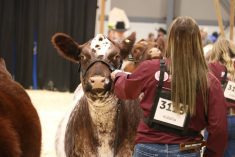Exhibitors from across Western Canada brought about 55 animals to the major livestock show in Regina
Mary-Jo Smith knew little about alpacas when she left Canada and moved to the United Kingdom 18 years ago.
But joining her aunt at Bozedown Alpacas in Reading, Berkshire, led her to becoming one of Britain’s premier breeders.
It is fitting then that the Albertan returned to Canada last month to judge the Premier Alpaca event at Canadian Western Agribition, held Nov. 19-24 in Regina. Alpacas haven’t shown at the annual event since 2001.
“This is my first time other than watching Canada from afar to actually get my hands on some alpacas,” she said during a break in the show. “The brown champion male and reserve champion that just came through were really nice. Some good bone, some good density and fineness so it’s good to see.”
Read Also

Farming Smarter receives financial boost from Alberta government for potato research
Farming Smarter near Lethbridge got a boost to its research equipment, thanks to the Alberta government’s increase in funding for research associations.
Exhibitors from the four western provinces brought about 55 alpacas to Regina. Barn boss and exhibitor Carol Poole from Tiger Lily Ranch at Edam, Sask., said she’s had alpacas for 22 years and is happy with the opportunity to return to the Agribition show ring.
Alpacas are judged on their fleece and on their conformation.
Poole said more producers are getting into the business.
“There are lots of little farms now and (alpacas) have got more attention the last two or three years,” she said.
A resurging interest in fibre arts such as spinning and knitting could be one reason. An alpaca produces between eight and 13 pounds of fleece that is hypoallergenic and three times warmer than wool, she said.
In England, Smith sells raw fleece.
“I’ve got quite a good market because of the quality of our fleece. I keep it clean and I grade it myself so there’s a high demand for me to sell it as raw fleece,” she said.
There are two types of alpacas: huacaya and suri.
“Huacayas are more like teddy bear fluffy animals,” Smith said. “Suris, their fleece grows down in a dreadlock form and it’s more lustrous. To see a suri in a full fleece is incredibly magical because as they move it’s like curtains swaying.”
At Bozedown, Smith has a herd of 700 alpacas; 500 of those are huacaya. The operation is one of the largest in the U.K., which has about 30,000 alpacas in total.
Smith said the popularity of alpaca fleece is likely to continue to grow.
“They say that a 27 micron alpaca (fleece) handles like an 18 micron merino, so alpacas have some amazing characteristics to their fleece that allow them to be a unique and luxurious product,” she said. “They rival cashmere but they’re more environmentally friendly on the ground than cashmere goats.”
Alpacas don’t graze the grass so far down to the ground, she explained.
“They’ve been doing feasibility studies in China for alpacas instead of the goats. Alpacas tick so many boxes.”
Smith picked Dreamin Jase, a fawn-coloured male from Dreamin Alpacas at Hague, Sask., as the supreme show champion.
Alpacas are judged within their breed and by colour.
Winners in the colour classes were: grand champion black, Tiger Park Osuna, reserve, Tiger Park Lu Senza, both from Tiger Park Alpacas at Foam Lake, Sask.; grand champion brown, Dreamin Conopa’s Rambo from Dreamin Alpacas, reserve Caley’s Warrior, Caley’s Alpacas, Camrose, Alta., reserve fawn, Tiger Lily Shaka’s Mercedes from Tiger Park; grand champion white, Tiger Lily Conopa’s Maroon from Tiger Park at Edam and Sunnyhills Alpacas, reserve, Birchleaf Complete from Mainstream Alpacas in Camrose.


















